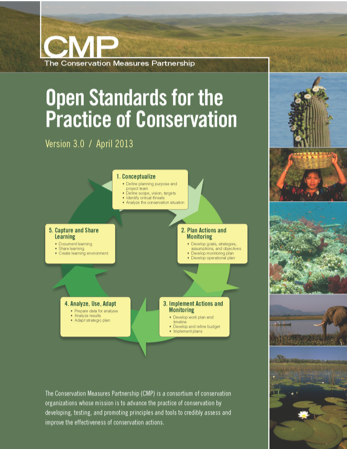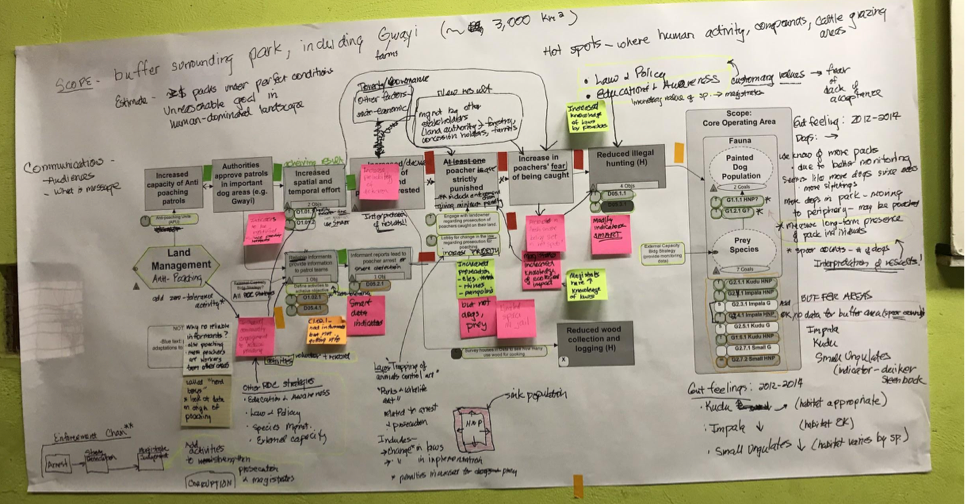Greetings from Caroline Stem, Coordinator of the Conservation Measures Partnership (CMP). CMP is a group of leading conservation organizations from around the world that recognizes the importance of a common language and process to facilitate learning within and across conservation efforts. CMP maintains a set of standards for designing, implementing, monitoring, and adapting conservation programs (Open Standards for the Practice of Conservation).

This blog describes two Open Standards tools – conceptual models and results chains. In a world of urgent and changing threats, scarce resources, and incomplete information, these tools help teams focus efforts, create shared understanding, and provide a framework for learning.
In Step 1 of the Open Standards, teams (often with partners) develop a conceptual model that depicts the context within which they are working. The conceptual model shows, in a graphically succinct fashion, what a team aims to conserve and the key forces affecting those priority conservation “targets.” Conceptual models help teams discuss and agree upon their context, the priority threats they face, the drivers behind those threats, and the appropriate actions to ultimately improve conservation.
Teams can then use another diagrammatic tool, results chains, to illustrate the theory of change (using if-then logic) behind each priority action. Results chains help teams think critically about potential actions, their likely success, and the enabling conditions needed to ensure their success. Results chains also provide a clear framework for setting programmatic objectives and indicators and evaluating effectiveness.
A real-world example: Painted Dog Conservation (PDC), based near Hwange National Park in Zimbabwe, is dedicated to reducing threats to African wild dogs. PDC’S programs are numerous and complex, and the PDC team was looking for a structured approach to responding to key threats and evaluating their effectiveness. In 2011, PDC developed a new strategic plan using the Open Standards, conceptual models, results chains, and Miradi Software.
PDC actively uses this plan, reviewing its results chains during quarterly and annual meetings to share and document data and discuss progress on priority actions, objectives, and goals. In December 2017, PDC held a workshop to assess which actions have worked, which have not, and why. The team is using the review results to evaluate the effectiveness of PDC actions since 2011 and to adapt PDC’s action and monitoring plans, laying the foundation for its 2018-2022 strategic plan.

PDC core team discussing results during the strategic plan review workshop

PDC progress data on its results chain
Rad Resources:
- The Open Standards, vetted guides, tools, and case studies can be found here.
- Miradi software and Miradi Share platform – software tools for implementing the Open Standards
- Webinar on Using the Open Standards to Support Evaluation
- Results Chains: A Tool for Conservation Action Design, Management, & Evaluation – journal article in Ecology and Society
- Using Conceptual Models as a Planning and Evaluation Tool in Conservation – journal article in Evaluation and Program Planning
- Example Using Results Chains to Evaluate an Ecotourism Strategy – journal article in PLOS One.
The American Evaluation Association is celebrating Environmental Program Evaluation TIG Week with our colleagues in the Environmental Program Evaluation Topical Interest Group. The contributions all this week to aea365 come from our EPE TIG members. Do you have questions, concerns, kudos, or content to extend this aea365 contribution? Please add them in the comments section for this post on the aea365 webpage so that we may enrich our community of practice. Would you like to submit an aea365 Tip? Please send a note of interest to aea365@eval.org. aea365 is sponsored by the American Evaluation Association and provides a Tip-a-Day by and for evaluators.
